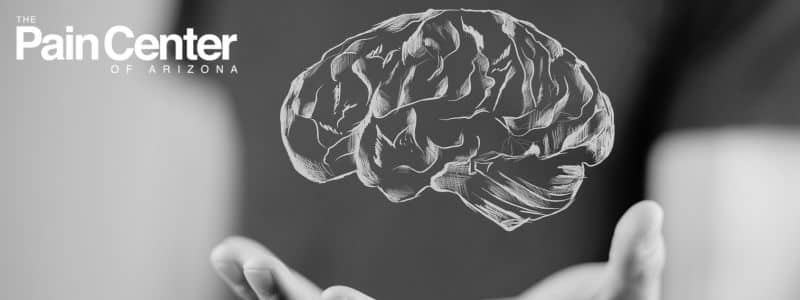
As technology advances, medical professionals continue developing new pain control methods for chronic conditions. In this blog, we’ll look at neuromodulation and its role in pain management.
We’ll go over the following:
- What is neuromodulation in simple terms?
- What is the purpose of neuromodulation?
- What is an example of neuromodulation?
- What is a neuromodulation device?
- Is neuromodulation FDA approved?
- What type of doctor performs neuromodulation?
- Chronic pain treatment at The Pain Center
What is Neuromodulation in Simple Terms?
Neuromodulation is a technology that targets the nerves through electrical stimulation to alter how the nerves communicate, alleviating chronic pain from various conditions.
What is the Purpose of Neuromodulation?

Neuromodulation is used to manage pain, improve muscle movement, and reduce the effects of chronic conditions and intractable pain. It can help patients who suffer from diseases like Parkinson’s. Along with physical pain, neuromodulation can help with neurological and psychiatric disorders like epilepsy, multiple sclerosis, and major depression.
What is an Example of Neuromodulation?
A patient with neuropathic pain due to a failed back surgery may use the neuromodulation method, Spinal Cord Stimulation (SCS), to alleviate pain. In this procedure, a small nerve stimulation device is implanted to deliver low-voltage electrical currents to the spine to reduce pain signals.
What is a Neuromodulation Device?
A neuromodulation device is a small implant designed to send electric, magnetic, or chemical stimulation to different areas of the nervous system, depending on the area of the body where the pain is located. It interferes with nerve activity and pain receptor signals that travel to the brain to reduce pain.
Is Neuromodulation FDA Approved?

There are various forms of neuromodulation, such as Deep Brain Stimulation (DBS) and Transcranial Magnetic Stimulation (TMS).
FDA approval for neuromodulation will vary depending on the method and the condition being targeted. For example, The Pain Center’s neuromodulation method Spinal Cord Stimulation is minimally-invasive and FDA-approved.
Other FDA-approved methods of neuromodulation include:
- Deep Brain Stimulation (DBS) for treating Parkinson’s disease, essential tremor, dystonia, and obsessive-compulsive disorder (OCD).
- Spinal Cord Stimulation (SCS) for failed back surgery syndrome, complex regional pain syndrome, and refractory neuropathic pain.
- Transcranial Magnetic Stimulation (TMS) for major depressive disorder in patients who have not responded to antidepressant medication.
- Vagus Nerve Stimulation (VNS) for treating epilepsy and treatment-resistant depression.
- Sacral Nerve Stimulation (SNS) for overactive bladder, urinary retention, and fecal incontinence.
What Type of Doctor Performs Neuromodulation?
Neurosurgeons typically perform neuromodulation. Neurosurgeons are physicians who specialize in the diagnosis and surgical treatment of chronic pain disorders of the central and peripheral nervous system. Their areas of expertise include brain surgery, spinal surgery, and peripheral nerve surgery. They’ll work with other healthcare professionals like neurologists and oncologists to ensure their patient receives proper care like neuromodulation therapies and medication support.
Chronic Pain Treatment at The Pain Center

TPC Spine Stim
TPC Spine Stim is for patients with chronic back or leg pain who haven’t responded to alternative, conservative treatments in the past six months. The TPC Spine Stim works by implanting a nerve stimulation device into your spine. The device delivers low-voltage electrical currents to areas of the spine to reduce the pain signals causing chronic pain.
TPC Spine Fuse
TPC Spine Fuse targets spinal degeneration, usually brought on by stenosis, spondylolisthesis, and related conditions. It works to alleviate pain due to pressure on the spinal cord and instability that causes painful movements of the vertebrate.
In this procedure, a small incision goes into the back under live X-ray guidance. A device is placed between the spinous processes that fuse the segment. This gives the back stability, where the bones shift forward and backward. Our procedure can also be done through alternative approaches (a posterior, oblique, or lateral approach) depending on each individual’s needs.
TPC Spine Lift
TPC Spine Lift is a spinal decompression treatment to relieve spinal nerve pressure pain. This procedure is designed to aid patients suffering from chronic pain due to spinal stenosis and related conditions.
Our procedure uses the Vertiflex technique, lifting the space where the lumbar vertebrae are narrowing or bulging (often resulting from spinal stenosis). This process is done under a live X-ray as guidance, placing a small device that opens up the pressure area.
TPC Sacral Fuse
TPC Sacral Fuse provides stability to the joints of patients with sacroiliac joint dysfunction. This condition can cause pain with too little or too much joint movement.
Under live X-ray guidance, a small device is placed into the sacroiliac joint, fusing the joint. Fusing the joint creates better stability, targeting pain caused by movement and instability.
TPC Peripheral Nerve Stimulation
The TPC Peripheral Nerve Stimulation offers pain relief to patients suffering from peripheral neuropathy and related conditions. A small electrical wire is surgically implanted along the damaged peripheral nerves, delivering rapid electrical pulses. These pulses feel like a mild tingling sensation, called paresthesias, and help to minimize pain.
TPC Spine Decompress
TPC Spine Decompress offers a minimally invasive method of pain relief for patients with spinal stenosis. In this treatment procedure, a small trocar needle is used to locate where the narrowing is causing the pain is occurring. Following this, we use a small instrument called the rongeur to remove excessive bone or tissue to open the area.




